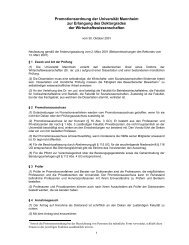The returns to cognitive and non-cognitive abilities in Germany
The returns to cognitive and non-cognitive abilities in Germany
The returns to cognitive and non-cognitive abilities in Germany
You also want an ePaper? Increase the reach of your titles
YUMPU automatically turns print PDFs into web optimized ePapers that Google loves.
1 <strong>The</strong> NLSY for <strong>in</strong>stance <strong>in</strong>cludes <strong>in</strong>dica<strong>to</strong>rs based on the Armed Forces Qualification Test (AFQT)<br />
which is derived from the Armed Services Vocational Aptitude Battery (ASVAB). <strong>The</strong> General<br />
Ability Test (GAT) which exists <strong>in</strong> the UK <strong>and</strong> <strong>in</strong> other Commonwealth nations is for example<br />
<strong>in</strong>cluded <strong>in</strong> the NCDS.<br />
2 See e.g. Tett et al. (1991), Barrick <strong>and</strong> Mount (1991), Salgado (1997), or Tokar et al. (1998).<br />
3 For references, cf. Judge et al. (1999).<br />
4 Note that there is a small set of personality traits surveyed from 1994 <strong>to</strong> 1996. We did not use these<br />
<strong>in</strong>dica<strong>to</strong>rs because the word<strong>in</strong>g changes from the 1994/95 <strong>in</strong>dica<strong>to</strong>rs <strong>to</strong> the 1996 items <strong>and</strong>, more<br />
severe, s<strong>in</strong>ce it would result <strong>in</strong> further sample size reduction.<br />
5 <strong>The</strong> sample size is rather low s<strong>in</strong>ce we have <strong>to</strong> restrict our sample <strong>to</strong> <strong>in</strong>dividuals who are SOEP<br />
respondents <strong>in</strong> both 2005 <strong>and</strong> 2006 <strong>and</strong>, which is more limit<strong>in</strong>g, were CAPI surveyed <strong>in</strong> 2006, s<strong>in</strong>ce<br />
only those were potential respondents of the ultra-short IQ-tests. That is, <strong>in</strong>stead of the 22,358<br />
observations available <strong>in</strong> the full sample we could work with only 5,545 observations of persons who<br />
<strong>to</strong>ok part <strong>in</strong> both tests <strong>and</strong> who could be matched <strong>to</strong> <strong>in</strong>dividuals who participated <strong>in</strong> the 2005 wave.<br />
This results <strong>in</strong> a drop of observations <strong>to</strong> 3,453 for which we then matched the preced<strong>in</strong>g waves. <strong>The</strong><br />
age restriction <strong>and</strong> further data clean<strong>in</strong>g result <strong>in</strong> an additional drop <strong>in</strong> sample size.<br />
6 Note that the full <strong>in</strong>ven<strong>to</strong>ry, the NEO PI-R, comprises 240 questions (Costa <strong>and</strong> McCrae, 1985).<br />
7 See Dehne <strong>and</strong> Schupp (2007) for an overview of the implementation of the short version of the Big<br />
Five <strong>in</strong>ven<strong>to</strong>ries <strong>in</strong> the SOEP. <strong>The</strong>y show amongst other th<strong>in</strong>gs the validity <strong>and</strong> reliability of the short<br />
version of the Big Five used <strong>in</strong> the SOEP.<br />
8 In general, separat<strong>in</strong>g external locus of control from <strong>in</strong>ternal locus of control is an advantage as this<br />
avoids a forced-choice format that would possibly lead <strong>to</strong> biased results if only one ‘<strong>in</strong>ternal-external’<br />
scale would be used (Ray, 1984).<br />
9 Not all items are used <strong>to</strong> generate the <strong>in</strong>dica<strong>to</strong>rs, s<strong>in</strong>ce explora<strong>to</strong>ry analyses showed that a few of the<br />
items resulted <strong>in</strong> low construct validity.<br />
10 Age-st<strong>and</strong>ardized scores are generated by calculat<strong>in</strong>g the scores’ st<strong>and</strong>ardized value (deviation from<br />
the sample mean divided by the st<strong>and</strong>ard deviation) for every year along the age distribution.<br />
44















